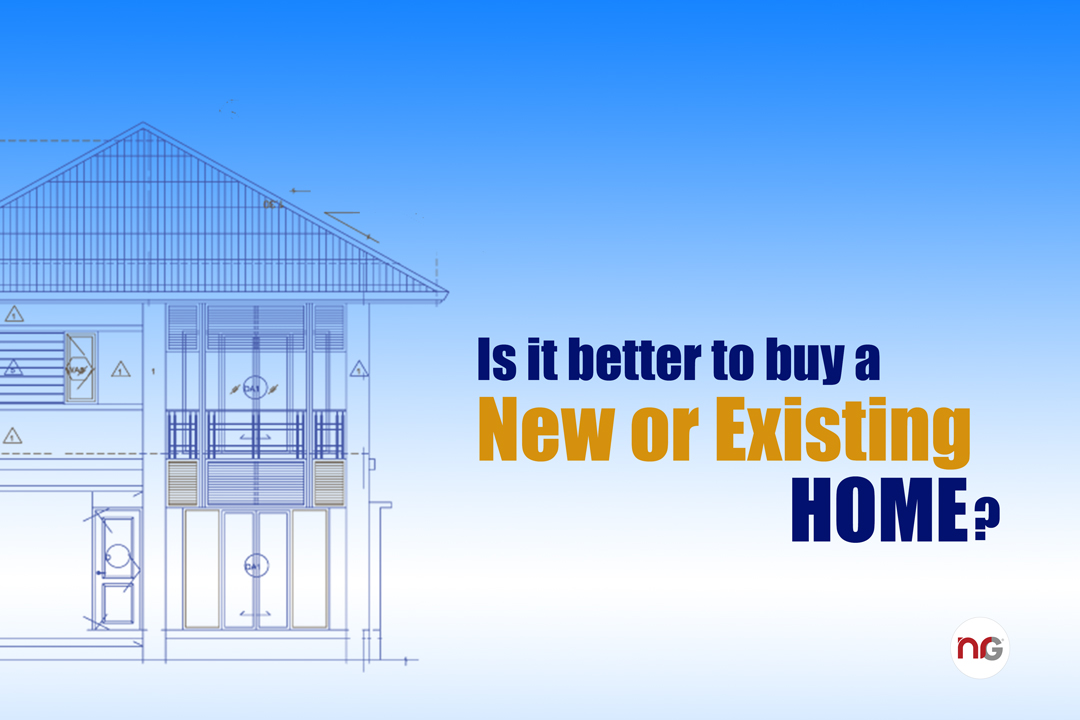Maybe your dream home has the intricate details that you usually find only in older construction – wainscoting and crown molding in the interior, the front porch with a swing, an older tree shading the backyard, and the white picket fence.
Or maybe your dream home has all the conveniences of modern living – open floor plan in the living and dining spaces, large windows, connected, “smart” appliances and security systems, and minimalist design elements.
Whether you go for a brand new construction or an existing home, both types of properties have their pros and cons when it comes to purchasing. What type of home is right for you will depend on which factors are most important for your lifestyle.
Build your dream home with new construction
If you’re making a home purchase that’s still in the pre-construction phase, you may be able to customize many of the details. Many home builders will give you the option to add design elements that will give you the exact dream home you desire. If it’s a new subdivision, you may even be able to pick which lot you like best.
Very early in the building process, you may have more room to customize. For example, if the walls aren’t complete, you may be able to add extra outlets in each of the rooms or custom wiring for surround sound in the media room. Perhaps you could move the laundry room to the top floor instead of the basement. You might be able to get a separate mudroom entrance.
Later in the building process, you may be able to add marble countertops, an island, and custom cabinets in the kitchen. Your master bathroom could be upgraded with a steam shower, spa tub, and European fixtures. You will want to check with the builder to understand which features are included, and which ones are extra.
New homes save money with fewer repairs and more efficiency
Once your home is complete, all you’ll need to do is move in. New appliances will be under warranty for a few years if they need repairs, and will likely work well for several years without needing fixes. Often, new construction is under a builder’s warranty, so any repairs needed in the first year should be covered.
New homes often contain energy efficient and green appliances, like high-efficiency stoves, refrigerators, washing machines, heaters, or air conditioning units. These energy-saving appliances, along with good insulation and energy-efficient windows, will help you save money on monthly utility bills.
New homes also often use new building materials that require less maintenance — for example, using composite siding instead of wood, which doesn’t need annual repainting. You won’t need to spend as much to maintain your new home.
If you customized it during pre-construction, you won’t need to spend any money on renovations or upgrades for several more years. You can just enjoy it and not worry about saving for major home repairs.
What you need to do to make a good new home purchase
Before you put in your offer, do some research on the builder. Do they have a good reputation? What else have they built? Did their other new properties have issues such as poor construction or unfinished details?
You like the model home, but will you like where it’s situated? After you look at the home itself, come back to the neighborhood to see what it’s like at different times of the day. Walk around during the day and in the evening, and see how you like the area.
Brand new communities usually attract similar types of buyers—urban professionals, couples, or young families, for example. These will be your neighbors, so you’ll want to make sure that you want to be part of this new, homogeneous community.
You may also need to be flexible with your move-in date. Builders will only be able to let you move in if they can meet their construction schedule. If the wiring is delayed, the walls can’t be finished. And because there are so many construction tasks that are dependent on the completion of prior tasks, schedules tend to slip.
Get more variety and established neighborhoods with an existing home
Existing homes are those that have generally been built and lived in between the 1920’s and 1970’s. With existing homes, you will get more variety in home styles, as different types of construction have gone in and out of style throughout the decades. Within one neighborhood, you may be able to find a mix of different styles like Victorian, modern Tudor cottages, tract style, ranch or split-ranch, or contemporary homes.
Existing homes are situated in established neighborhoods, which may have more amenities nearby that a new home in a brand new subdivision may not have. Your new neighborhood may have restaurants, cafes, and boutiques within walking distance.
You might also have access to more supermarkets, dry cleaners, discount stores, and gas stations nearby. An established neighborhood might have a nice park, running path, or playground for the kids to enjoy. You might also be closer to a library or the post office.
Resale homes can be a less expensive purchase
If you’re considering a resale home, you may be able to get into a beautiful, unique property at a lower purchase price than a new home.
There are many more resale homes available than there are new homes — according to the National Association of Homebuilders, about 10 times as many. With such a large pool to buy from, the market for resales can be more competitive. You may have more room to negotiate the selling price of the home. With a brand-new construction, you won’t likely be able to have the same kind of negotiating power.
Before putting a home on the market, sellers often make home renovations or remodel parts of their homes to make them more attractive to buyers and to be able to potentially increase the list price. If the resale home has a brand new, modern kitchen, an updated bathroom, or even a new roof or upgraded windows, you could end up getting a home that’s comparable to new construction without having to pay the potential more expensive new-home list price.
Existing homes have already been inspected at least once on the last sale, so you will know about any potential structural problems or repairs that have been made in the home. Knowing the track record of your potential home will help you avoid purchase mistakes—you’re much less likely to end up with a property that has a rotting roof, dangerous electrical wiring, or a crumbling foundation. With a new home, you could end up with incomplete construction or major issues that you didn’t know about because they weren’t yet documented.
What you need to do to make a good resale purchase
Before you go too far down the road to a purchase, you can protect your purchase by first having the home inspected. A good home inspector will document all flaws, no matter how small they appear. If the inspector finds any major problems, like foundation cracks or leaky roofs, you may be able to counter offer and get the seller to either fix it or reduce the selling price.
Even if the inspection doesn’t uncover any major issues, you will need to expect the unexpected. Older homes will eventually need replacement appliances, a new air conditioning unit, or a plumbing repair. As long as you know that before you buy a resale home, you can plan for surprise repairs.
With an older home, you may want to eventually remodel parts of it. Will you be happy living in your house while you’re doing major work in the living room or the kitchen? If you know that it would disrupt your lifestyle too much, you may want to consider whether you really want to buy an older property.
Whether you choose to buy a new home or an existing home, the best way to get started is to speak with your trusted real estate professional. We will have access to both new properties and resale homes that may fit your goals and will know which neighborhoods will serve your needs.
Nadereh (Nana) Rezaie, P.A. Broker Associate, Certified Luxury Home Marketing Specialist™ GUILD™


Nana Rezaie 561-660-1948
Office: 561-472-1236 1400 Corporate Center Way, Second Floor, Wellington, FL 33414 Each office independently owned and operated.

All listings featuring the RAPB + GFLR logo are provided by the Realtors® of the Palm Beaches and Greater Fort Lauderdale Inc. and BeachesMLS, Inc. This information is not verified for authenticity or accuracy and is not guaranteed. Copyright 2023 by Realtors® of the Palm Beaches and Greater Fort Lauderdale Inc. and BeachesMLS, Inc.
The properties displayed are provided courtesy of Real Estate Brokers participating in the Realtors® Association of the Palm Beaches and Greater Fort Lauderdale Inc. and BeachesMLS, Inc. Multiple Listing Service Internet Data Exchange Program (IDX). The information provided on this site is provided exclusively for consumers' personal, non-commercial use to identify prospective properties they may be interested in purchasing. Every effort has been made to maintain the highest degree of accuracy of data represented on this site. Up to date information is achieved by replicating pertinent Multiple Listing Service data every hour, subject to point-to-point Internet access availability. No representation is made as to the accuracy of any information regarding listed properties for sale, rental, taxes or financing. All information is subject to errors, omission, change of price, rental, commission, proper sale, lease or financing, or withdrawal without notice. All square footage and dimensions are approximate. Please consult a professional for exact dimensions. In the event your property is listed on this site and you discover errors, please contact your listing broker to remedy the discrepancy. We are only capable of correcting our own listings. Our listing data concerning your individual property will self-correct once your listing broker has corrected the errors with of the Palm Beaches and Greater Fort Lauderdale Inc. and BeachesMLS, Inc. MLS service.



